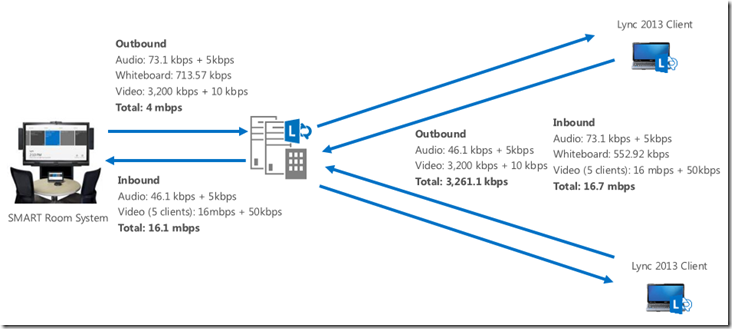SMART Room System Bandwidth Consumption
The SMART Room System for Microsoft Lync is SMART’s solution for Microsoft’s Lync Room System (https://blogs.technet.com/b/lync/archive/2013/02/19/the-lync-room-system-lrs.aspx). As any other Lync 2013 client, it consumes bandwidth that can be controlled, managed and administered by the Lync 2013 infrastructure.
Lync Room System is very similar to the regular Lync 2013 desktop client, except for the following caveats:
- Audio Codec: G.722 stereo
- Lync P2P video calls to/from LRS start in full screen mode on LRS screen (UI suppression), which kicks 720p or 1080p (default) from the very start of the meeting
- Dual screen LRS might go for even higher resolutions since video tiles are distributed on both screens (gallery view). LRS could be receiving a real estate of 240p per Lync 2013 client being displayed.
Keeping in mind the guidance of Lync Media Traffic (https://technet.microsoft.com/en-us/library/jj688118.aspx) and Lync 2013 Networking Guide (https://blogs.technet.com/b/nexthop/archive/2013/06/04/lync-server-2013-networking-guide-network-planning-monitoring-and-troubleshooting-with-microsoft-lync-server.aspx) , we can estimate the approximate bandwidth usage of the SRS:
Media |
Scenario |
Codec |
Typical bandwidth + RTCP |
Audio |
P2P, Conferencing |
G.722 Stereo |
73.1 kbps + 5 kbps |
Video |
1920x1080 (16:9) |
H.264 |
3,200 kbps + 10 kbps |
Now this is only taking into account audio and video feeds, but we also need to add content sharing or application sharing if it’s being used (https://technet.microsoft.com/en-us/library/gg425781%28v=ocs.14%29.aspx):
Media |
Typical |
Application sharing using Remote Desktop Protocol (RDP) |
434 kbps sent per sharer |
Application Sharing Capacity Planning for Persistent Shared Object Model (PSOM) Applications |
Sent per sharer: 713.57 kbps Received per viewer: 552.92 kbps |
Sample Typical Scenario of SRS presenting Whiteboard
Important note:
This is a sample scenario and depicts these specific assumptions:
- All are Lync 2013 clients
- 5 Lync 2013 clients in meeting, plus the SRS
- All Lync 2013 desktop clients are sending typical H.264 1080p video (3,200 kbps) and G.722 (46.1 kbps) to the server
- We won’t take into account the bandwidth consumption upload and download of the Whiteboard at the beginning of the meeting, but only when the meeting has already started and participants are fully engaged.
These are sample values, your own scenarios will vary depending on how your Lync conferencing policies and Call Admission Control is set up, therefore you should consider the following to have a great meeting room experience:
- Microsoft uses Quality of Experience for all Lync video/audio/web calls, therefore the bandwidth consumption in all calls is dynamic. (https://www.microsoft.com/en-us/download/details.aspx?id=6412). That means that a call that started consuming x kbps may consume less or more (adjusting dynamically) during the meeting without the end users knowing it’s being adjusted. Lync client doesn’t go below the minimum and doesn’t go beyond the maximum thresholds depicted in the Networking Guide and Media Traffic guide (https://technet.microsoft.com/en-us/library/jj688118.aspx)
- The only way to “control the dynamism” of Lync QoE is to establish conferencing policies and CAC (Call Admission Control) in Lync Server to audio and video, which would enable you to “cap” the max used for audio and video. Lync conferencing policies can be applied to any Lync client, including the LRS client. Note that Lync Conferencing Policies in Lync Server can be complemented with QoS policies as well.
Guidance and resources on how to do this can be found here:
- Configuring video bandwidth in Lync: https://technet.microsoft.com/en-us/library/jj204842.aspx
- Video sample scenarios: https://technet.microsoft.com/en-us/library/jj205297.aspx
- Controlling video bandwidth: https://masteringlync.com/2013/02/05/controlling_video_bandwidth/
- Overview of CAC (Call Admission Control): https://technet.microsoft.com/en-us/library/gg398529.aspx
- Managing QoS in Lync Server 2013: https://technet.microsoft.com/en-us/library/gg405409.aspx
